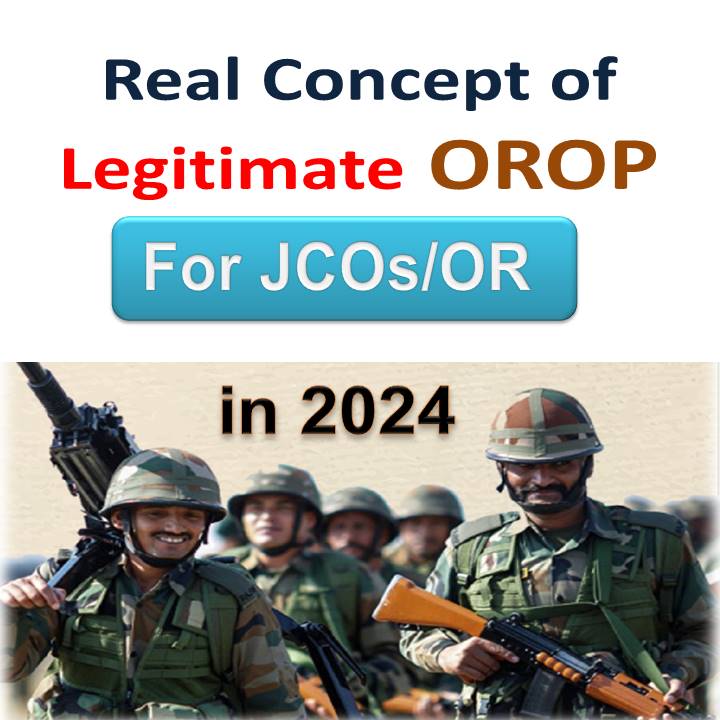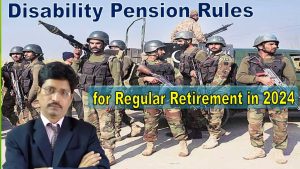OROP has been implemented for all ranks of Indian Army in 2015 and got benefit from July 2014 by only a few soldiers. OROP Pension table has been prepared by the Defence Accounts Department based on the methodology suggested by the DESW. Do you know what was suggested by the DESW regarding OROP pension table ? Lets have a look on the contents of the letter :-
“1. In view of the need of the Defence Forces to maintain physical fitness, efficiency and effectiveness, as per the extant Rules, Defence Service personnel retire at an early age compared to other wings in the Government. Sepoy in Army and equivalent rank in Navy & Air Force retire after 17/19 years of engagement/service and officers retire before attaining the age of 60 years i.e. the normal age of retirement in the Government. Considering these exceptional service conditions and in the interest of ever vigilant Defence Forces, the pensionary benefits of Ex-Servicemen have accordingly, over time, been fixed.
2. It has now been decided to implement “One Rank One Pension” (OROP) for the Ex-Servicemen with effect from 1.07.2014. OROP implies that uniform pension be paid to the Defence Forces Personnel retiring in the same rank with the same length of service, regardless of their date of retirement, which, implies bridging the gap between the rates of pension of current and past pensioners at periodic intervals.
3. Salient features of the OROP are as follows:
To begin with, pension of the past pensioners would be re-fixed on the basis of pension of retirees of calendar year 2013 and the benefit will be effective with effect from 1.7.2014.
| ii. Pension will be re-fixed for all pensioners on the basisof the average of minimum and maximum pension of personnel retired in 2013 in the same rank and with the same length of service. |
iii. Pension for those drawing above the average shall be protected.
iv. Arrears will be paid in four equal half yearly instalments. However, all the family pensioners including those in receipt of Special/Liberalized family pension and Gallantry award winners shall be paid arrears in one instalment.
v. In future, the pension would be re-fixed every 5 years.
4. Personnel who opt to get discharged henceforth on their own request under Rule 13(3)1(i)(b),13(3)1(iv) or Rule 16B of the Army Rule 1954 or equivalent Navy or Air Force Rules will not be entitled to the benefits of OROP. It will be effective prospectively.
5. The Govt. has decided to appoint a Judicial Committee to look into anomalies, if any, arising out of implementation of OROP. The Judicial Committee will submit its report in six months.
6. Detailed instructions relating to implementation of OROP along with tables indicating revised pension for each rank and each category, shall be issued separately for updation of pension and payment of arrears directly by Pension Disbursing Agencies.”
After issuing this order, PCDA has prepared an OROP pension table for all ranks based on minimum pension and maximum pension drawn as on a cutoff date.
It has been found that the difference of pension in case of commissioned officers was huge because of the introduction of time bound promotion after 2004. Those retired/ promoted before 2004 was drawing too less pension compared to those retiremed /promoted after 2004. As a result, the average pension of maximum and minimum drawn as on cutoff date in case of OROP -I and 2 both the duration, proved to be too beneficial to a large number of retired officers.
Whereas in case of JCOs/OR no such uniform time bound promotion scheme is available till date. So, no such difference is found with the legacy pensioners in comparison with the pensioners retired in recent days. As a result, OROP has failed to increase the pension significantly for JCOs/OR.
Veterans Associations comprising retired JCOs/OR have been agitating at Jantar Mantar and other places of India since long. Their demand is to fix the OROP Pension as per Maximum pension drawn on the cutoff date by the pensioners of the same rank and length of service. The matter has been demanded to the Ministry of Defence and other Govt authorities.
Here is an illustration of OROP Pension table based on maximum pension drawing by veterans of a particular rank and length of service.
OROP-2 Pension for Hav / Y Gp 15 Years of Service – Rs 21782
(Based on average of max and min pension)
OROP-3 Pension for Hav / Y Gp 15 Years of Service (if it consider maximum pension)
Last Pay of a Hav who was promoted at 4 years of service and retired after 15 years of total service is –
Basic Pay – Rs 40,400 + MSP Rs. 5,200/- .
Total pay Rs 45,600/-
So, Pension to be fixed @ Rs 22,800/-
So, you can imagine that the maximum of pension, if counted to fix as OROP Pension, will be beneficial to approx 97% of Soldiers belong to JCOs/OR category. The real concept of OROP is to draw equal pension for equal rank and service and it can be true if the Govt follow the formulae of maximum drawn pension and scrap the average pension formulae.
At present the OROP formula applied to the JCOs OR found beneficial to only 30% veterans. Remaining 70% got no benefit of OROP due to wrong concept of OROP implemented in 2015.
Whereas, it has been found that in case of Commissioned Officer, the number of veterans benefitted due to OROP is more than 60%. In maximum cases, the increase in pension found more than 10,000/-. Whereas in case of JCOs/OR the benefit of OROP pension increas is less than Rs 1000/-. Ration of pension amount of JCOS/OR and Officer is maximem 1:4 but the increase in pension due to OROP found 1:10.
That is the reason the JCOs/OR are agitating since long to reform the OROP and introduce the actual OROP, so that maximum soldiers can be benefitted from the scheme that aimed to extend maximum benefit and provide livelyhood support to the soldiers.
- SPARSH Defence Pension PCDA (P) Allahabad Phone Number Email IDAre you looking for contact number of PCDA allahabad to … Read more
- Injustice with Jawan & JCOs Rank of Indian Armed ForcesIn Indian Armed forces, soldiers are the backbone of National … Read more
- Military Disability Pension Rules for Retirement on Completion of Coloured Service in 2024 Soldiers, sailors and Airmen are very often assigned a versatile … Read more
- Definite Solution to Award Real OROP for JCOs OR by Defence Ministry : Suggested VeteransIt is well known that peaceful agitation of veterans is … Read more
- List of Benefits Applicable to Veterans and Armed Forces Personnel & FamilyDirectorate of Indian Army Veterans Directorate has published detailed information … Read more
- Exservicemen may get Computerised Printed I card Now from ZSBGood news for Exservicemen. Have you ever checked your ESM … Read more







